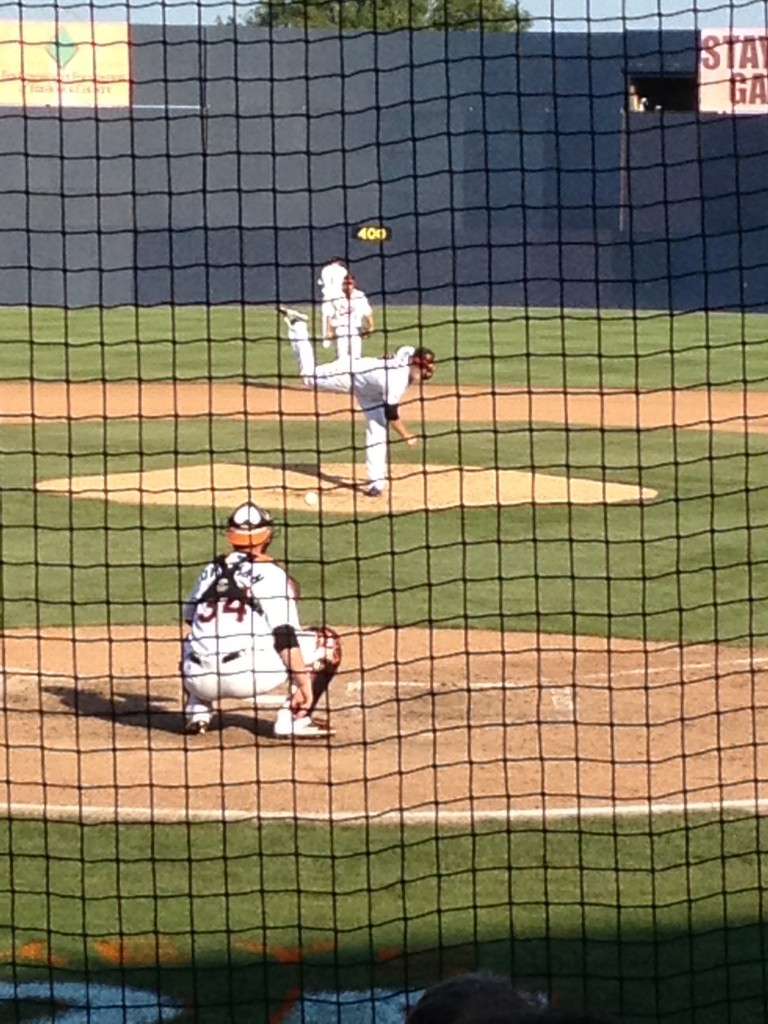In honor of Tom Cochrane and wanting to spend yet another mild summer afternoon in the sun, Sunday I scouted the Frederick Keys, the High-A affiliate of the Baltimore Orioles, as they hosted the Myrtle Beach Pelicans, the High-A minor league affiliate for the Texas Rangers, at Harry Grove Stadium.
I drove to Frederick eager to witness a stark contrast of starting pitchers, as the Keys featured knuckleballer Zach Clark, who was opposed by massive, hard-throwing right-handed pitcher Alec Asher. I could not pass on the opportunity to watch a true knuckleballer in action from directly behind the plate. These are my notes from Sunday’s contest, a game which Myrtle Beach dominated with a 6-0 victory over the home team.
Zach Clark RHP Frederick
One of the very few knuckleballers currently pitching in professional baseball, Clark throws his knuckleball between 62-69mph, with the slower version moving downward like a split-finger and the faster knuckler tending to break more quickly and horizontally. Clark also throws an 85-88mph fastball which he throws for strikes down in the zone. He throws the knuckle ball about 70% of the time, almost exclusively when ahead in the count, and will throw the fastball mainly when behind the batter. His delivery is relatively clean and simple, and he repeats it fairly well with both pitches.
Unfortunately Sunday Clark struggled to locate his knuckleball in the strike zone, especially in the first few innings, allowing the hitters to sit on his fastball while letting the knuckler float out of the zone. His key, and the key for all knuckleballers, is the ability to control the pitch enough to throw it for strikes, which is extraordinarily difficult and the reason so few exist in the majors.
That said Clark did show potential with the pitch during his 5 innings, throwing the occasional knuckler for a strike later in his appearance and inducing some awkward swings-and-misses from confused Pelican batters. Clark faces the difficult challenge of taming the uncontrollable knuckleball if he hopes to reach the major leagues, but with a little improvement he has a chance to spend some time in the major leagues. Baseball needs more knuckleball pitchers, so good luck to Zach in his climb toward The Show.
Alec Asher RHP Myrtle Beach
A physical, intimidating presence on the mound, Asher features a four-pitch mix consisting of a fastball, slider, curveball, and changeup. Asher’s fastball Sunday was consistently 90-93mph touching 94mph with some life but was somewhat flat and lacking movement. His above-average slider is perhaps his best pitch, sitting at 84-87mph with harsh downward tilt that he can locate for strikes. In addition, Asher shows an occasional overhand 78-82mph curveball with potential and an 82-84mph changeup with some deception and armside movement.
The 21-year-old is still inconsistent with the quality of his arsenal, but Asher has the potential to have two above-average pitches in his fastball and slider, and possibly an average curveball and changeup. Considering his massive frame and with additional refinement in the minors, Asher projects as a durable, innings-eating #4 or #5 starting pitcher in the big leagues. Asher should start 2014 in Double-A and could reach the major leagues sometime in 2015.
Matt Hobgood RHP Frederick
The Orioles 1st Round pick, 5th overall, in the 2009 draft, Hobgood has struggled with injuries in past seasons before being converted to relief this season. Hobgood has thrived in the bullpen, as he started 2013 at Low-A Delmarva before recently receiving a promotion to Frederick.
Hobgood entered in relief of Clark in the 6th inning and featured four pitches in his fastball, curveball, slider, and changeup in keeping the opposing batters off-balance. His fastball was consistently 89-92mph on my radar gun, reaching 93mph, and showed some noteworthy armside movement and downward sink.
Now 23-years-old and strictly a reliever, Hobgood should consider focusing on only one breaking pitch, eliminate the other, and continue to only use the changeup as a “show me” pitch to keep lefties honest. This decision could expedite his rise toward the big leagues. Likely to fall short of the lofty expectations on a top draft pick, Hobgood seems to have found his niche in the bullpen, and has a legitimate chance to reach the majors as a reliever.
Others of Note:
Michael Ohlman Catcher Frederick
Although his calling card is his hitting ability, I was particularly impressed by Ohlman’s catching ability Sunday afternoon, as his skills were put to an extreme test by a wild knuckleball pitcher – Ohlman passed with flying colors, showing soft, quiet hands catching the ball, impressive agility blocking pitches in the dirt, and a strong throwing arm throwing out a runner attempting to steal second base in the 5th inning.
Ohlman’s size works against him behind the plate, and he is still below-average defensively, but he deserves credit for making excellent improvement as a receiver this season. Without question his bat will be the reason he reaches the major leagues, but with further refinement his defense should not hinder his progress to the big leagues.
Jason Esposito 3B Frederick
One of my favorite players from the 2011 draft, Esposito has disappointed since being drafted, and especially in 2013, hitting only .232/.282/.304 over 293 at-bats. Sunday continued more of the same from this enigma, as he went 0-3 with 2 strikeouts, yet in his struggles he still showed good bat speed and a pretty swing at the plate. The talent is readily apparent, but now 23-years-old and scuffling in High-A, Esposito needs to start turning his potential into production or risk never climbing the organizational ladder.




Yes , I have always wondered about how we got all of these players .if I have the bucks I would say round up some more players and fresh out of school. But these guys are grand players they need to be paid but I have never seen baseball with speeds of anything like this. Thank you for time.